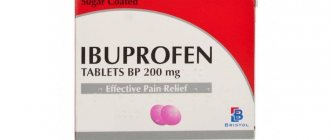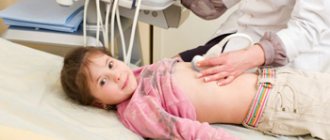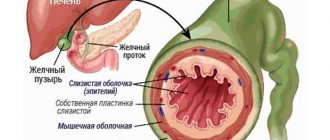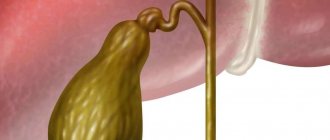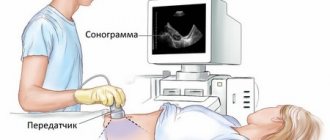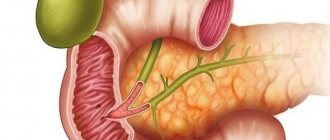General rules
Diet for gallbladder disease is an essential component of treatment for both acute and chronic forms of cholecystitis , cholangitis (inflammation of the bile ducts), and biliary dyskinesia . The basic diet for these diseases is Table No. 5 and its varieties.
In case of acute cholecystitis, in order to maximize sparing of the gastrointestinal tract in the first days, complete fasting is indicated. Only warm drinks in small portions are allowed: weak sweet tea, berry and fruit juices diluted with water, rosehip infusions. On days 3-4, an anti-inflammatory version of diet No. 5 is prescribed - Diet 5B .
Light food in pureed form without broth and butter is introduced into the diet in limited quantities: slimy soups (oatmeal, rice, semolina), liquid pureed oatmeal and rice porridges with a small addition of low-fat milk, pureed compotes, jellies, vegetable juices. Then include in small quantities well-mashed steamed meat, low-fat cottage cheese, boiled fish, wheat bread or crackers.
Meals are fractional, in small portions (at least 5 times), without sodium chloride , with plenty of liquid (up to 2.5 l/day). The calorie content of the daily diet is 1600 kcal (50-60 g protein, 40-45 g fat, 200-250 g carbohydrates). On days 8-10 the patient is transferred to Diet 5A and then to Diet No. 5 .
In case of chronic cholecystitis (without exacerbation), the main principles of dietary nutrition are maximum sparing of the gallbladder and liver with physiologically adequate nutrition, normalization of bile secretion and cholesterol in the blood, and in the absence of diarrhea , strengthening of intestinal function ( Diet No. 5 ).
Small and frequent meals are provided to promote the outflow of bile. To enhance bile secretion, salads and vinaigrettes seasoned with unrefined vegetable oils are introduced into the diet. The diet includes various vegetables, berries and fruits that stimulate the process of bile secretion, and the high fiber content eliminates constipation .
All easily digestible carbohydrates (jam, sugar, sweets, honey) are excluded or sharply limited from the diet, since their consumption leads to stagnation of bile, as well as vegetables containing oxalic acid (sorrel, spinach) and essential oils in large quantities (citrus fruits). The diet includes chicken eggs (not more than one), but it must be remembered that yolks enhance the motor function of the gallbladder and have a choleretic effect.
For pain or bitterness in the mouth caused by eating eggs, only egg whites are included in the diet. The calorie content of the daily diet is at the level of 2700-2900 kcal (proteins -100 g, including animals - 60%, fats -90 g, including vegetable 30%, carbohydrates -450 g).
Salt consumption is limited (10 g), liquid at the level of 1.5-2 liters. With a sharp exacerbation of chronic cholecystitis, the diet is similar to the diet for acute cholecystitis .
For combined diseases of the pancreas and gall bladder ( pancreatitis + cholecystitis ), Table No. 5P . This table is characterized by an increase in the content of proteins and vitamins and a restriction in the diet of fatty and carbohydrate foods.
Products containing a lot of extractives and purine bases (cabbage broth, meat and fish broths), refractory fats of animal origin, and sugar are excluded from the diet. Avoid hot, spicy, sour, sweet and fatty foods that stimulate the function of the pancreas, as well as foods rich in fiber. Food is cooked mainly by steaming, meals are divided into small portions. The total caloric content of the diet is reduced to 2500 Kcal.
After operations
After removal of the gallbladder, it is important to create such conditions in the digestive system so that bile does not linger in the bile ducts, but is actively excreted. This is achieved through fractional nutrition.
The more meals a day in small portions, the more smoothly the body works.
It is recommended to divide the diet into 5-6 meals. Fried food is strictly prohibited, as it irritates the mucous membranes of the stomach and can cause stagnation of bile.
Varieties
The varieties of Diet No. 5 include, in addition to those described above, also a lipotropic-fat diet - 5 l/f. Prescribed to patients with cholecystitis for problems caused by stagnation of bile. cholesterol from it .
The diet increased the fat content (50% of which is vegetable oils), slightly increased the protein content (up to 100 g) and reduced the amount of carbohydrates (300 g) by limiting sugar. Total calorie content is 2600 kcal.
The diet provides for a sharp limitation in the consumption of extractive substances (meat and fish broths), cholesterol and foods containing large amounts of essential oils. The diet is enriched with lipotropic protein products (egg whites, cottage cheese, lean meat, fish), refined vegetable oils, wheat bran, vegetables and fruits.
All types of oils (butter and vegetable) are added only to ready-made dishes. Refractory animal fats, butter dough, spices, and whole milk are excluded. Food is prepared by baking or boiling; chopping is not necessary.
What can you eat?
The diet is indicated for diseases of the gallbladder, biliary tract and liver, along with therapeutic measures. The diet is selected by the doctor taking into account the patient’s condition and the complexity of the disease.
Recommended to use:
- pureed vegetable-based soups;
- juices with water (diluted 50/50);
- rosehip decoction;
- stale bread;
- pasta;
- steam omelette (1 egg per day);
- lean meat, as well as cutlets and other steamed meat dishes;
- sea or river fish with low fat content;
- potatoes, cauliflower, zucchini and other vegetables, raw or boiled;
- cereals;
- dairy products with a small percentage of fat content;
- honey, marmalade;
- non-sour jam;
- weak tea.
One serving should contain no more than 300 g, since large volumes can provoke a timely outflow of bile.
Foods high in protein and low in fat are recommended. However, they must be present in the diet for the body to function properly. For this purpose, it is recommended to use vegetable oils.
Authorized Products
Permitted products and dishes include vegetable and cereal soups with vegetable broth, beetroot soup, vegetarian cabbage soup, milk soups with pasta, fruit soups, dried wheat bread, dry biscuits, savory pastries with fish, boiled meat or cottage cheese, and apples. Meat - chicken fillet, lean young lamb, beef, rabbit, milk sausages. Low-fat white fish and seafood.
The diet should contain dairy products: kefir, fermented baked milk, yogurt, whole low-fat milk, low-fat cottage cheese and dishes based on it (casseroles, puddings, lazy dumplings), mild, low-fat cheese. Chicken eggs in the form of an omelet and soft-boiled eggs are allowed. Cereals (especially oatmeal and buckwheat), boiled pasta.
The diet should contain vegetables both raw and in various forms of cooking (stewed and boiled), non-acidic sauerkraut, green pea puree, vegetable salads with vegetable oil, vinaigrette, squash caviar, and greens. As snacks, the diet includes low-fat herring, diet, doctor's sausage, stuffed fish, lean ham, boiled fish and meat.
Sweet products include various non-acidic fruits and berries, dried fruits, marmalade, jam, honey, marshmallows. It is recommended to combine sugar with xylitol ( Sorbitol ). All fats (butter and vegetable oil) are introduced into the dish in their natural form. Recommended drinks: black/green tea, vegetable, fruit and berry juices, decoction of wheat bran and rose hips, still mineral water.
Table of permitted products
| Proteins, g | Fats, g | Carbohydrates, g | Calories, kcal | |
Vegetables and greens | ||||
| eggplant | 1,2 | 0,1 | 4,5 | 24 |
| squash caviar | 1,2 | 7,0 | 7,4 | 97 |
| cabbage | 1,8 | 0,1 | 4,7 | 27 |
| broccoli | 3,0 | 0,4 | 5,2 | 28 |
| bulb onions | 1,4 | 0,0 | 10,4 | 41 |
| carrot | 1,3 | 0,1 | 6,9 | 32 |
| cucumbers | 0,8 | 0,1 | 2,8 | 15 |
| salad pepper | 1,3 | 0,0 | 5,3 | 27 |
| parsley | 3,7 | 0,4 | 7,6 | 47 |
| radish | 1,2 | 0,1 | 3,4 | 19 |
| iceberg lettuce | 0,9 | 0,1 | 1,8 | 14 |
| tomatoes | 0,6 | 0,2 | 4,2 | 20 |
| dill | 2,5 | 0,5 | 6,3 | 38 |
Fruits | ||||
| bananas | 1,5 | 0,2 | 21,8 | 95 |
| apples | 0,4 | 0,4 | 9,8 | 47 |
Nuts and dried fruits | ||||
| nuts | 15,0 | 40,0 | 20,0 | 500 |
| raisin | 2,9 | 0,6 | 66,0 | 264 |
| dried apricots | 5,2 | 0,3 | 51,0 | 215 |
| almond | 18,6 | 57,7 | 16,2 | 645 |
| hazelnut | 16,1 | 66,9 | 9,9 | 704 |
| prunes | 2,3 | 0,7 | 57,5 | 231 |
Cereals and porridges | ||||
| buckwheat | 4,5 | 2,3 | 25,0 | 132 |
| oatmeal | 3,2 | 4,1 | 14,2 | 102 |
| pearl barley porridge | 3,1 | 0,4 | 22,2 | 109 |
| rice | 6,7 | 0,7 | 78,9 | 344 |
Flour and pasta | ||||
| pasta | 10,4 | 1,1 | 69,7 | 337 |
| pancakes | 6,1 | 12,3 | 26,0 | 233 |
Bakery products | ||||
| bran bread | 7,5 | 1,3 | 45,2 | 227 |
| whole grain bread | 10,1 | 2,3 | 57,1 | 295 |
Dairy | ||||
| kefir 1.5% | 3,3 | 1,5 | 3,6 | 41 |
| Ryazhenka | 2,8 | 4,0 | 4,2 | 67 |
Cheeses and cottage cheese | ||||
| cottage cheese 1% | 16,3 | 1,0 | 1,3 | 79 |
Meat products | ||||
| beef | 18,9 | 19,4 | 0,0 | 187 |
| rabbit | 21,0 | 8,0 | 0,0 | 156 |
Sausages | ||||
| boiled diet sausage | 12,1 | 13,5 | 0,0 | 170 |
| boiled milk sausage | 11,7 | 22,8 | 0,0 | 252 |
| milk sausages | 12,3 | 25,3 | 0,0 | 277 |
Bird | ||||
| boiled chicken breast | 29,8 | 1,8 | 0,5 | 137 |
| boiled chicken drumstick | 27,0 | 5,6 | 0,0 | 158 |
| boiled turkey fillet | 25,0 | 1,0 | — | 130 |
Eggs | ||||
| hard-boiled chicken eggs | 12,9 | 11,6 | 0,8 | 160 |
Fish and seafood | ||||
| flounder | 16,5 | 1,8 | 0,0 | 83 |
| pollock | 15,9 | 0,9 | 0,0 | 72 |
| cod | 17,7 | 0,7 | — | 78 |
| hake | 16,6 | 2,2 | 0,0 | 86 |
Oils and fats | ||||
| butter | 0,5 | 82,5 | 0,8 | 748 |
| olive oil | 0,0 | 99,8 | 0,0 | 898 |
| sunflower oil | 0,0 | 99,9 | 0,0 | 899 |
Non-alcoholic drinks | ||||
| water | 0,0 | 0,0 | 0,0 | — |
| green tea | 0,0 | 0,0 | 0,0 | — |
| * data is per 100 g of product | ||||
Cholecystitis
For cholecystitis of the gallbladder, nutrition is selected in accordance with the phases of the disease. If the patient endures the acute phase, immediately after an attack and exacerbation, the diet should be extremely gentle on the liver.
During the acute period, the patient can drink only water, as well as weak vegetable broths. On the second day, you can use secondary meat broths.
The chronic form of the disease implies a somewhat more flexible diet. The patient can prepare dishes with lean meats, seafood, and fish. You should not eat more than one egg white per day. It is also advisable to avoid lard and lard.
Oatmeal and buckwheat porridge are recommended for patients; pasta and noodles are allowed. Of the fruits, preference should be given to the sweetest and most ripe ones; greens, especially parsley, will also be useful.
Pears are traditionally considered useful for cholecystitis . They can speed up the patient’s recovery process and even cure the disease. Among the drinks, rosehip decoction and homemade apple compote will have a beneficial effect.
Fully or partially limited products
Mushroom, meat and fish broths, green cabbage soup, and okroshka are completely excluded from the menu; solid animal fats (cooking fats, pork, lamb lard), fatty pork, goose meat, duck meat, offal (brains, liver, kidneys), most sausages, smoked meats, canned food, fresh bread, dough (butter, puff pastry), fried pies, fried and hard-boiled chicken eggs, smoked, salted and fatty fish, canned fish, full-fat cottage cheese, cream, whole milk 6% fat, sour cream, salted cheese, seasonings (pepper, mustard, horseradish) and sauces.
Irritating gastrointestinal tract and difficult-to-digest products of plant origin are limited: all types of legumes (peas, beans, chickpeas, soybeans), mushrooms, sorrel, radishes, spinach, radishes, green onions, garlic, pickled and canned vegetables. You cannot include spicy and fatty snacks, various caviar, as well as ice cream, chocolate, confectionery, cocoa, carbonated and alcohol-containing drinks, black coffee, sour berries, fruits, and juices from these products in your diet.
Table of prohibited products
| Proteins, g | Fats, g | Carbohydrates, g | Calories, kcal | |
Vegetables and greens | ||||
| canned vegetables | 1,5 | 0,2 | 5,5 | 30 |
| peas | 6,0 | 0,0 | 9,0 | 60 |
| chickpeas | 19,0 | 6,0 | 61,0 | 364 |
| beans | 7,8 | 0,5 | 21,5 | 123 |
| spinach | 2,9 | 0,3 | 2,0 | 22 |
| sorrel | 1,5 | 0,3 | 2,9 | 19 |
Berries | ||||
| grape | 0,6 | 0,2 | 16,8 | 65 |
Snacks | ||||
| potato chips | 5,5 | 30,0 | 53,0 | 520 |
Flour and pasta | ||||
| vareniki | 7,6 | 2,3 | 18,7 | 155 |
Bakery products | ||||
| sliced loaf | 7,5 | 2,9 | 50,9 | 264 |
| buns | 7,9 | 9,4 | 55,5 | 339 |
Confectionery | ||||
| cookie | 7,5 | 11,8 | 74,9 | 417 |
Ice cream | ||||
| ice cream | 3,7 | 6,9 | 22,1 | 189 |
Chocolate | ||||
| chocolate | 5,4 | 35,3 | 56,5 | 544 |
Raw materials and seasonings | ||||
| mayonnaise | 2,4 | 67,0 | 3,9 | 627 |
Dairy | ||||
| milk 4.5% | 3,1 | 4,5 | 4,7 | 72 |
| cream 35% (fat) | 2,5 | 35,0 | 3,0 | 337 |
Cheeses and cottage cheese | ||||
| gouda cheese | 25,0 | 27,0 | 2,0 | 356 |
| parmesan cheese | 33,0 | 28,0 | 0,0 | 392 |
Meat products | ||||
| fatty pork | 11,4 | 49,3 | 0,0 | 489 |
| salo | 2,4 | 89,0 | 0,0 | 797 |
| bacon | 23,0 | 45,0 | 0,0 | 500 |
Sausages | ||||
| smoked sausage | 9,9 | 63,2 | 0,3 | 608 |
Bird | ||||
| duck | 16,5 | 61,2 | 0,0 | 346 |
| goose | 16,1 | 33,3 | 0,0 | 364 |
Fish and seafood | ||||
| salmon | 19,8 | 6,3 | 0,0 | 142 |
| salmon | 21,6 | 6,0 | — | 140 |
| trout | 19,2 | 2,1 | — | 97 |
Alcoholic drinks | ||||
| white dessert wine 16% | 0,5 | 0,0 | 16,0 | 153 |
| dry red wine | 0,2 | 0,0 | 0,3 | 68 |
| vodka | 0,0 | 0,0 | 0,1 | 235 |
| beer | 0,3 | 0,0 | 4,6 | 42 |
Non-alcoholic drinks | ||||
| soda water | 0,0 | 0,0 | 0,0 | — |
| cola | 0,0 | 0,0 | 10,4 | 42 |
| * data is per 100 g of product | ||||
Features of diet 5 during remission and exacerbation
For cholecystitis, biliary dyskinesia, hepatosis, a diet for the liver and gallbladder is prescribed - table No. 5. If you have pain in the gallbladder, heaviness in the liver, or nausea after eating fatty foods, you must adjust your diet.
Table No. 5 involves reducing the calorie intake, giving up animal fats and simple carbohydrates. You need to consume plant foods that normalize the flow of bile.
The diet for different diseases is different:
- In acute cases, it is necessary to relieve the digestive organs as much as possible. Table No. 5a will help with this. First, the patient must fast for 2-3 days. Next, you need to avoid solid foods to reduce inflammation. It is also better to exclude salt from the diet. You need to drink 2 liters of filtered water per day. It is also allowed to drink weak unsweetened tea, vegetable broth, jelly, decoctions of dried fruits, rose hips (without sugar). After a few days, you can move on to pureed soups and cereals. When the condition improves, diet No. 5 is prescribed.
- In the chronic form, the diet becomes more varied. The main thing is to eat low-fat foods, give up sweets, and reduce the dose of sugar. Confectionery products are replaced with fruits. It is recommended to eat organic foods and follow a regular diet.
If the functionality of the gall bladder is impaired, it is prohibited to drink alcohol-containing drinks.
Menu (Power Mode)
It is necessary to organize 6 meals a day and ensure that the diet includes alternating protein dishes (beef, chicken, fish, turkey, cottage cheese) and cereals.
Below is a three-day nutrition menu of the main Table No. 5 , which can be modified at will, observing the basic principles of processing and not going beyond the limits of permitted products.
First day
| Breakfast |
|
| Lunch |
|
| Dinner |
|
| Afternoon snack |
|
| Dinner |
|
| For the night |
|
Second day
| Breakfast |
|
| Lunch |
|
| Dinner |
|
| Afternoon snack |
|
| Dinner |
|
| For the night |
|
The third day
| Breakfast |
|
| Lunch |
|
| Dinner |
|
| Afternoon snack |
|
| Dinner |
|
| For the night |
|
What is allowed?
Doctors do not immediately allow a person to eat properly. The first few days after removal of the gallbladder by laparoscopy you will have to sit on water and low-fat, secondary broth.
Secondary broth is a broth that is cooked on already cooked meat. A lean piece of beef is boiled to a boil, the first broth needs to be drained, and the meat should be filled with water again and the broth should be cooked.
From the third day onwards it is allowed to gradually introduce additional food into the diet, usually starting with dairy and fermented milk products.
Doctors recommend getting into the habit of having milk porridge for breakfast: rice, buckwheat, wheat. But to do this, do not cook the porridge in milk, but steam it with boiling water overnight, and pour it with warm milk in the morning.
The food taken by the patient after surgery should be warm, and in no case hot or cold - this leads to additional irritation of the mucous membrane and the secretion of bile.
Puddings, cheesecakes, cottage cheese casseroles, omelets and boiled eggs are also allowed. Such protein breakfasts can balance the secretion of bile and allow it to easily move through the biliary tract without being delayed.
For lunch, it is better to cook hot dishes in low-fat or secondary broths with the addition of cereals and vegetables. Vegetables should be well boiled and chopped finely.
It is recommended to give preference to vegetable or fish broths. Porridge with boiled beef or brisket is good for second courses. Baked or boiled sea fish is recommended several times a week.
Diet recipes
First meal
Zucchini soup
Ingredients: zucchini, potatoes, tomatoes, carrots, onions, parsley (root), butter, vegetable broth, sour cream 10%.
Vegetables: carrots, onions, parsley root, chop and simmer in water with added butter. Place the chopped potatoes into the vegetable broth, and after 15 minutes add the stewed roots, chopped zucchini, tomato, and salt. When serving, sprinkle with chopped herbs. Serve with sour cream if desired.
Vegetarian pearl barley soup
Ingredients: potatoes, cereals, carrots, onions, parsley (root), butter, sour cream 10%.
Boil pearl barley until half cooked. Chop the carrots, parsley root, onion and simmer in water with butter. Combine the cereal with the roots, pour in the vegetable broth, add potatoes, and salt. Serve with parsley and sour cream.
Second courses
Stuffed cabbage rolls with boiled meat and rice
Composition of products. Cabbage, tomatoes, rice, parsley, meat, sour cream, salt.
Disassemble the head of cabbage and cook the leaves until half cooked in salted water. Pass the meat through a meat grinder, combine with cooked rice and herbs. Spread the minced meat on the leaves and wrap. Place the cabbage rolls in a saucepan, add vegetable broth and put on fire. After boiling, add salt. Place chopped tomato and grated carrots on top and cook covered. Serve with sour cream.
Casserole of boiled chicken and vegetables
Ingredients: chicken, flour, butter, milk, carrots, cauliflower, tomato, zucchini, egg white, vegetable oil, salt.
Finely chop the boiled chicken meat, add part of the milk sauce (made from flour and milk) and whipped egg white. Place the minced meat in a mold, place chopped vegetables on top and stew them in butter and water. Pour in the remaining milk sauce, butter and bake in the oven.
Pasta with boiled meat
Ingredients: beef, onion, pasta, vegetable oil, egg, milk, salt. Boil the meat, finely chop, add onion. Boil the pasta. Place a layer of pasta in a deep dish, spread out the minced meat and the second layer of pasta. Prepare a sauce from beaten eggs, milk and salt, pour it over the pasta bowl and bake.
Pike perch baked in sour cream
Ingredients: pike perch fillet, sour cream sauce, onion, salt.
Place pike perch fillet or carcass pieces in a mold, add salt, sprinkle with onion rings, pour in sour cream sauce and bake.
Hake poached with vegetables
Ingredients: hake, onion, zucchini, carrots, bell pepper, tomato, vegetable oil.
Place the hake fillet in a saucepan. Simmer diced zucchini, tomato and sweet pepper, and grated carrots in a frying pan with the addition of vegetable oil and water. Transfer the prepared vegetables to the fish, add salt and simmer under the lid until cooked.
Dessert
Cheesecakes with carrots and dried apricots
Ingredients: cottage cheese; 0.5 eggs; flour; sugar; carrot; dried apricots; butter; sour cream 10%.
Grate the carrots and simmer with a little water and butter. Chop the dried apricots. Mash the cottage cheese well, add flour, egg, a little sour cream, dried apricots, carrots and sugar. Mix everything, form cheesecakes, bake in the oven. Serve with sour cream.
Pumpkin porridge with millet
Ingredients: peeled pumpkin, butter, milk, millet cereal, sugar.
Chop the pumpkin and simmer with milk and water until soft. Add cooked cereal, sugar and salt. Cook until done, adding milk or water if necessary. Can be served with butter.
Dry biscuit
Ingredients: two eggs, 50 g flour, 40 g sugar.
Prepared from biscuit dough, baked in the form of flat cakes or sticks. Beat eggs with sugar until the mass increases 3 times. Add the sifted flour and mix gently. Place the dough in the form of sticks on a baking sheet with baking paper, greased with oil. Sprinkle the products with sugar and bake for 10-15 minutes at 2400.
Dietary recipes and recommended menu for gallbladder disease
The patient's menu may be as follows: Breakfast: oatmeal or buckwheat porridge with vegetable oil, cottage cheese, weak tea or fruit infusion.
Second breakfast: vegetables or fruits.
Lunch: vegetable and cereal soup, a piece of boiled meat (chicken, veal or turkey), jelly or a dried fruit drink.
Afternoon snack: tea or rosehip decoction, dry cookies.
Dinner: lean porridge, boiled fish, weak tea.
Second dinner: low-fat milk or kefir.
An important place in the patient's diet is given to decoctions of choleretic plants (rose hips, St. John's wort, tansy, immortelle).
It is necessary to prepare decoctions of choleretic herbs daily and take them 2-3 times a day 15 minutes before meals.
And although a patient with cholecystitis or cholelithiasis should give preference to dietary products, you can diversify the menu of such a patient with simple, but tasty and healthy dishes.
Fish soufflé
To prepare the soufflé, boil cod fish fillet (200 g), grind in a blender or mince, mix with flour (1 tbsp), yolk (1 pc.) and salt. Add the beaten egg white and place the prepared mixture into a buttered container. Fish soufflé can be baked in the oven or steamed.
Cream soup
To prepare vegetable puree soup, take potatoes (2-3 pcs.), carrots (1 pc.), ½ cup of low-fat milk, rice (1 tbsp.), fresh dill. Boil the peeled vegetables along with the rice. Then mix them with milk and beat with a blender, adding a little salt. Boil the prepared mixture and remove from the stove. Garnish the prepared puree soup with dill and serve along with croutons.
Potatoes with veal
To prepare a tasty and healthy side dish, take a piece of veal (200 g), which you boil along with carrots. Prepare mashed potatoes. Prepare milk sauce by mixing flour (1 tbsp) with hot low-fat milk (50 ml). Place the prepared puree and sliced meat in a frying pan, pour in milk sauce and sprinkle with grated cheese. Bake the dish in the oven for 5-7 minutes.
Advantages and disadvantages
| pros | Minuses |
|
|
What is good for the gallbladder
Doctors have identified healthy dishes and foods for the liver and gallbladder:
- Bread (stale or dried), biscuits, sponge cake without additives.
- Chicken, turkey, rabbit, veal, etc.
- Low-fat fish (hake, cod).
- Milk, kefir, natural yogurt with live bacteria. Acceptable fat content is up to 2.5%.
- Egg whites or no more than 1 boiled egg per day.
- Buckwheat, oatmeal, brown rice, millet, grade A pasta.
- Potatoes, zucchini, carrots, cauliflower, seaweed, pumpkin, etc.
- Sweet fruits (apples, pears, strawberries, raspberries).
- Butter, vegetable oils.
Sometimes you can enjoy honey, jam (from sweet varieties), marshmallows, and marmalade.
Reviews and results
Feedback from patients confirms the need for therapeutic nutrition, which has a beneficial effect on the gastrointestinal tract. As a result of such nutrition, the patients’ condition improves significantly: heaviness in the right hypochondrium, bloating of the intestines decrease, belching and constipation . More often there are reviews from patients with chronic cholecystitis , hepatitis and those who have had viral hepatitis A.
- “... I have chronic cholecystitis. During an exacerbation, she was treated in a hospital and prescribed a diet for the gallbladder. I've been sticking to it for two months now. For me, this is the only way out, otherwise it will worsen again”;
- “... After Botkina’s illness, she ate this way for 4 months. I’m used to it, the food is nutritious, almost all foods are acceptable, except fatty and fried foods”;
- “... In case of exacerbation of cholecystitis, as soon as the first symptoms of gallbladder disease appear, I immediately go on a diet. As it subsides, I’m gradually expanding my diet”;
- “... I prepared this for my child for six months when he suffered from viral hepatitis”;
- “... The food is healthy and wholesome, I don’t feel inferior, although I eat like this all the time. What is the use of fried belyashi and chebureks?”;
- “... I cook everything for my husband in a double boiler (he has chronic calculous cholecystitis) and have taught the whole family to eat this way. This is healthy eating";
- “... After cholecystectomy, I sat on table 5 for 2 months, then I started eating everything, little by little”;
- “... Due to illness, I started eating this way, and my family got used to stewed and low-fat dishes”;
- “... Nutritional therapy makes sense. During an exacerbation, I strictly monitor my diet for a month and noticed that I even lose weight during this time.”
Prohibited Products
You should exclude foods that would irritate the walls of the stomach and intestines, as this will inevitably lead to the accumulation of bile and pain. The list of exceptions includes mushrooms, hot herbs and spices, garlic, radishes, fatty rich broths, marinades.
After surgery to remove the gallbladder, the amount of the lipase enzyme responsible for the breakdown of fats is sharply reduced. Therefore, the supply of the latter should be limited - these are fats, lard, fatty parts of pork, as well as semi-finished products, for example, sausages, sausages, cutlets from the store.
Strictly prohibited: alcohol, ice cream, sauerkraut, beans, jellied meat. Cold foods cause spasms in the bile ducts, preventing the release of bile.



